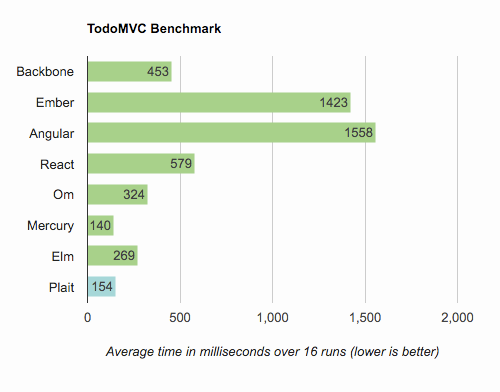Plait is a minimal JavaScript framework for building isomorphic reactive web components. It is loosely based on The Elm Architecture and Elm's StartApp.
Inspired by the experience of writing reactive applications in Elm, Plait is an attempt at achieving a similar application architecture with a minimal amount of JavaScript.
In Plait, an application is composed of one or more encapsulated components. A component is made up of 3 functions: init, which provides the component's initial state; view, which renders the component at a given state and attaches actions to the UI elements; and update, which modifies the component's state based on actions dispatched from the UI.
Component state is implemented as an immutable map. Behind the scenes, the state is contained & managed by Redux. A component's update function is just a Redux reducer.
Component views are written in virtual-hyperscript and rendered by virtual-dom. DOM events are transparently handled by dom-delegator.
With minimal effort, component views can be written in JSX and compiled to virtual-hyperscript using jsx-transform.
The following is an example of an application composed of a single counter component. View the demo
Note: For more complex example applications, see the Plait documentation.
import h from 'virtual-dom/h'
import Plait from 'plait'
const app = Plait.start({ init, update, view })
Plait.render(document.getElementById('app'), app)
function init () {
return {
count: 0
}
}
function update (state, action) {
switch (action.type) {
case 'DECREMENT':
return state.update('count', x => x - 1)
case 'INCREMENT':
return state.update('count', x => x + 1)
}
}
function view (state, dispatch) {
return (
<div>
<button ev-click={dispatch({ type: 'DECREMENT' })}>-</button>
<span>{state.get('count')}</span>
<button ev-click={dispatch({ type: 'INCREMENT' })}>+</button>
</div>
)
}Plait is extremely fast compared to other popular JavaScript frameworks. Like Mercury and Elm, this is in large part due to the use of virtual-dom as well as a focus on immutability and purity.
Using the TodoMVC app as a benchmark, Plait performs better than Elm and almost as well as Mercury. You can run the benchmark yourself to see.
The MIT License (MIT)
Copyright (c) 2016 Joseph Wynn
Permission is hereby granted, free of charge, to any person obtaining a copy of this software and associated documentation files (the "Software"), to deal in the Software without restriction, including without limitation the rights to use, copy, modify, merge, publish, distribute, sublicense, and/or sell copies of the Software, and to permit persons to whom the Software is furnished to do so, subject to the following conditions:
The above copyright notice and this permission notice shall be included in all copies or substantial portions of the Software.
THE SOFTWARE IS PROVIDED "AS IS", WITHOUT WARRANTY OF ANY KIND, EXPRESS OR IMPLIED, INCLUDING BUT NOT LIMITED TO THE WARRANTIES OF MERCHANTABILITY, FITNESS FOR A PARTICULAR PURPOSE AND NONINFRINGEMENT. IN NO EVENT SHALL THE AUTHORS OR COPYRIGHT HOLDERS BE LIABLE FOR ANY CLAIM, DAMAGES OR OTHER LIABILITY, WHETHER IN AN ACTION OF CONTRACT, TORT OR OTHERWISE, ARISING FROM, OUT OF OR IN CONNECTION WITH THE SOFTWARE OR THE USE OR OTHER DEALINGS IN THE SOFTWARE.



